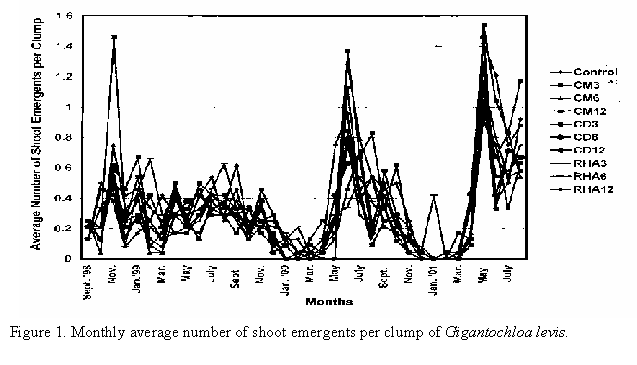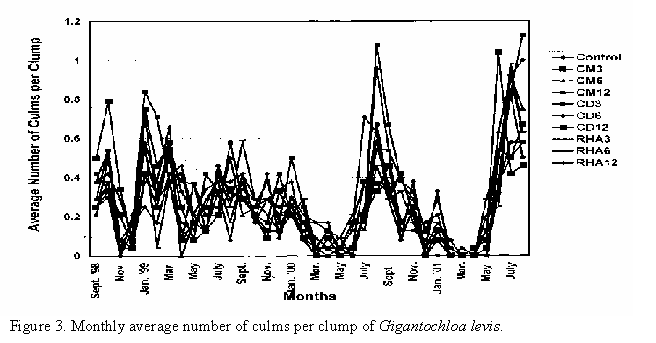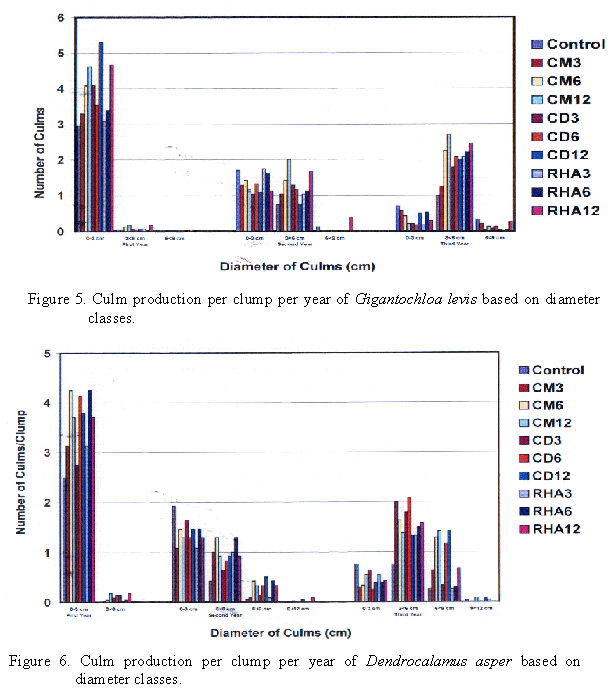

Fernandez, E. C 1 , A. M. Palijon 2 , W. Liese 3 , F. L. Esguerra 4 , and R. J. Murphy 5
The growth performance of newly established stands of Dendrocalamus asper and Gigantochloa levis grown on marginal lands and fertilized with three organic fertilizers was assessed over a period of 3 years. The results indicated a high survival (100%) and comparatively good growth and development of both species in the field. The influence of organic fertilizers on average number of shoot emergents, number of culms per clump, average height, and culm diameter was only significant during the first year of plantation establishment.
Bamboo is widely distributed, mainly in the tropical, subtropical and mild temperate zones of the world, with the tropical belt having the maximum number of bamboo species. Worldwide, approximately 87 genera and over 1,500 species of bamboo exist (Ohrnberger, 1999) and among these nearly 62 are found in the Philippines (Rojo, 1996).
Intensified interest on bamboos has resulted in their emergence as potentially the most important non-timber forest resource to replace wood. Their strength, straightness, lightness combined with extraordinary hardness, range in size, abundance, easy propagation, and short vegetation period to attain maturity, make them suitable for a variety of purposes and uses (Espiloy, 1994). Furthermore, bamboo as a woody plant is uniquely suited to agroforestry. Some of the many uses of bamboo in agroforestry are: 1) intercropping; 2) riparian vegetation filter; 3) constructed wetlands; 4) living screens; and 5) permaculture (Diver, 2001).
With its intensive utilization, bamboo is now an exploited plant and the supply of raw material decreased. In this regard, the knowledge of bamboo production plays an important role. There are several production techniques that can be employed to improve and increase the number of harvests, and therefore, meet the high demand for bamboo. One of these is the application of either organic or inorganic fertilizers. Thus, this project was undertaken to assess the effect of organic fertilizers on the productivity and stand quality of Gigantochloa levis (Blanco) Merr. and Dendrocalamus asper (Schultes f.) Becker.
Two pachymorph bamboo species were used in the study, namely: Dendrocalamus asper (Schultes f.) Backer ex Heyne and Gigantochloa levis (Blanco) Merr. Culm cuttings were collected from the Makiling Forest Reserve, UPLB College of Forestry and Natural Resources in February and March of 1998.
Propagation and Culture of the Planting Stocks in the Nursery
A mist propagation chamber was constructed for better rooting of bamboo culm cuttings. Culms of approximately 1 to 2 year old were selected as source of clones. Using sharp handsaws, culms were divided into one-nodal culm cuttings with about 5-8 cm basal internode, 20-25 cm upper internode and one-nodal branch stub. Twelve (12) culm cuttings were obtained from the upper portion of the culm from G. levis and D. asper. Immediately after collection, these one-nodal culm cuttings were placed in the mist propagation chamber for two months. G. levis and D. asper had 64% and 75% rooting, respectively.
All rooted cuttings were potted in 18 cm x 18 cm x 28 cm poly-bags pre-filled with ordinary garden soil. The plants were cared and maintained in the nursery for only 3 to 4 months. The planting materials were then transported in the site (Laguna-Quezon Land Grant) with an area of 2.16 ha. The site has an elevation of 500 to 530 m above sea level with rolling topography. It is characterized by the absence of dry season, with pronounced maximum rain period from October to December. The average total rainfall is approximately 4000 mm. The soil is very acidic with low nutrient content, high water holding capacity, and bulk density.
Plantation Establishment and Maintenance
A month before outplanting, brushing and clearing were done. Each planting spot was staked and holes of 50 cm wide and 50 cm deep were prepared. Cow dung (CD), chicken manure (CM) and rice hull ash (RHA) were used as organic fertilizers. For each species, split-plot experimental design, having 3 types of fertilizers and 4 rates of application to be replicated 4 times was laid out in the area. In each block or plot, 3 subplots of various fertilizer types (CM, CD, RHA) were established. Each subplot was further subdivided into 4 sub-subplots which corresponded to various rates of application. Basal application of fertilizers was done before putting the planting stock in the hole. The rates of fertilizer application were 0, ½ kg, 1 kg and 2 kg per plant or hill with a frequency once every two months. During the second year of plantation, the fertilizers were applied quarterly at the rates of 0, 0.75 kg, 1.5 kg and 3 kg rates and on the third year, the fertilizers were applied every six months at 0, 1.5 kg, 3 kg and 6 kg rates.
Growth data which include number of shoot emergents as well as number, height, and diameter of developed culms were measured every month. The last measurement was done on July 31, 2001.
Statistical Analysis
The Analysis of Variance (ANOVA) was used to determine if the difference between treatments were significant. The Duncan Multiple Range Test (DMRT) was used to compare means of the treatments.
Effects of organic fertilizers on survival
The survival rates of both species in all organic fertilizer treatments including the control were 100% after a year of plantation. This very high survival can be attributed to the quality of the nursery stocks rather than due to organic fertilizer application. As mentioned earlier, only healthy and vigorous stocks were used. Potted rooted cuttings were nurtured and hardened in the nursery before they were outplanted. Well hardened, high quality potted planting stocks when field planted with their root ball intact can easily survive the harsh conditions in the planting site (Agpaoa, et al., 1975; PCARRD, 1991; Denison, 1979; Hartman and Kester, 1959).
Effects of organic fertilizers on monthly average number of shoot emergents during the 3 year of plantation development
Figures 1 and 2 show the monthly trends in shoot production of G. levis and D. asper, respectively. During the 3 year period, a similar see- saw pattern but with variable peaks and low monthly average shoot emergence had been observed in all the fertilizer treatments and the control. The pattern seemed to be correlated with rainfall distribution in the area. As pointed out by Farrelly (1984), shoot emergence in sympodial bamboos is apparently controlled by moisture levels. Thus, normally, shoots will emerge during the growing or rainy season. Very few shoots if ever there are, arise during the dry season when the soil moisture is at its lowest (Uchimura, 1978). In warm regions with frequent and well-distributed rainfall throughout the year, the growth may be virtually continuous (Latif et al., 1998).

According to Uchimura (1978), vegetative growth of bamboos is more affected by soil moisture rather than by temperature. At the first splash of rain, usually in the latter part of May, new buds emerge as a result of more moisture in the soil. The availability of soil moisture and the decreased in temperature during the rainy season influence the emergence of shoots. In our study, April was the month with lowest rainfall. It started to increase in May and shoot emergence became very aggressive in June.

Effects of organic fertilizers on monthly average number of shoots that developed into culms
Shoot emergents will ultimately develop into culms. In this study, the shoots that emerged and grew to its maximum height and about to produce the first branch were recorded as developed culms.

It takes less than two months or 45 to 50 days for the shoots to fully develop into a culm, attain their maximum height and start to produce their branches. Ideally, the number of shoots that developed into culms is directly related to number of shoots that emerged. Effects of the various fertilizer treatments on monthly average number of shoots that developed into culms in both species varied (Figures 3 and 4). The peak in shoot production approximated the slump in culm development and vice versa (Figures 3 and 4). Hoanh (1992) made the same observation for Bambusa blumeana that fertilizer application enhances growth and yield. Most of the new bamboo shoots fully developed into new culms within 3 to 4 months during rainy season. This pattern only confirms the growth trend described by Suwannapinunt et al. (1988), Maoyi et. al. (1988), Uchimura (1980), Mc Clure (1966) and Holttum (1958).

Effects of organic fertilizers on average total shoot emergents and culms, height and diameter after 6 months, 1 year, 2 years and 3 years of plantation development
Average number of shoot emergents
In G. levis, significant differences in the effects of organic fertilizers on shooting were only manifested during the 6 months and two years of plantation development but not on the 1 st and 3 rd year. Among the individual treatments, the 12 kg CM gave the highest average total number of shoot emergents. In D. asper, however, no significant differences in the effects of organic fertilizers on all growth parameters were observed during the 3 year of plantation development. Among the individual treatments, the 6 kg CM gave the highest average number of shoot emergents.
Average number of culms
In G. levis, significant differences on the effects of organic fertilizers on the average number of culms occurred only during the 6 months and one year of plantation development and not on the 2 nd and 3 rd year. Treatment with 12 kg RHA gave the highest average total number of culms per clump. However, there is no significant difference on the total number of culms per clump among fertilizers and rates of application after three years of plantation development. In D. asper, no significant differences on the effects of organic fertilizers on the average number of culms were observed in all the growth monitoring periods during the 3 years of plantation development. Treatment with 6 kg CM gave the highest average total number of culms per clump.
Average height and diameter of culms
In G. levis, no significant effects of organic fertilizers on height and diameter growth were observed in all the growth monitoring periods during the 3 years of plantation development. Treatment with 12 CM gave the highest average total height and diameter, respectively. Also in D. asper, no significant effects of organic fertilizers on height were observed. The effects on diameter were not significant during the 6 months, 2 nd , and 3 rd year of plantation. Only for the first year the 12 kg CD resulted in bigger culms than the other treatments including the control.. However, treatment with 12 kg CM gave the highest average total height and diameter, respectively.
Successional growth of culms

Figures 5 and 6 show the successional growth pattern of G. levis and D. asper, respectively. It can be noted that profuse shooting in all the treatments including the control occurred on the first year with culms mostly having a diameter of up to 3 cm and few with diameter of more than 3 to 6 cm.
During the second year, culms of G levis were in all the treatments including the control almost equal in number with diameter classes of less than 3 cm and 3 to 6 cm. In D. asper , however, culms of less than 3 cm were greater in number than those with more than 3 to 6 cm diameter. During the three years plantation also culms of 6 to 9 cm and 9 to 12 cm developed.
On the third year of the plantation, G. Levis developed were still some culms with less than 3 cm. However, most cu;ms developed a diameter of 3 to 6 cm, and few even 6 to 9 cm. In D. asper, the greater number of culms had diameter of 3 to 6 cm and 6 to 9 cm.
Production of vegetatively propagated planting materials is possible even without rooting hormone application using mist-propagation chamber. Likewise, it is possible to convert marginal lands such as an unproductive coconut plantation, into productive lands using these two bamboo species namely, G. levis and D. asper. The high survival (100%) and comparatively good growth and development of both species in the field, with or without organic fertilizer treatments, proved that these bamboo species can be grown in high elevation areas with acidic soil, particularly if there is well distributed rainfall throughout the year. The influence of the three organic fertilizers tested on growth and development of both bamboo species was only significant during the first year of plantation establishment. Culms having more than 6 cm in diameter developed in both species during the third year of the plantation. This implies that on the fifth and sixth year of plantation development, harvest of commercial culms is already possible.
Abd. Latif, M. and W. Liese. 1998. The moisture content of two Malaysian bamboos in relation to age, culm height, site and harvesting month. Proceedings 5th International Bamboo Congress, San Jose, Costa Rica, 2-6 November 1998. 10 p.
Agpaoa, A., et al. 1975. Manual on Reforestation and Erosion Control for the Philippines. German Agency for Technical Cooperation, LTD. West Germany.
Denison, N. P. 1979. Developments in nursery practice, establishment procedures and tree improvement for afforestation. South African Forestry Journal 110:12.
Diver, S. 2001. Bamboo. A Multi-purpose Agroforestry Crop. Current Topic. Appropriate Technology Transfer for Rural Areas (ATTRA), August 2001. 13 p.
Espiloy, Z. B. 1994. Effect of age on the physico-mechanical properties of some Philippine bamboo. In Bamboo in Asia and the Pacific. Proceedings of the 4 th International Bamboo Workshop, Chiangmai, Thailand, 27-30 November 1991. International Development Research Centre, Ottawa, Canada; Forestry Research Support Programme for Asia and the Pacific, Bangkok, Thailand. pp. 180-182.
Farrelly, D. 1984. The Book of bamboo: a comprehensive guide to this plant, its uses and its history. Sierra Club Books. San Francisco. CA, United States of America. 340 p.
Gonzales, L.L. and P.A. Umali.1995 . The Art and Technique of Establishing Bamboo plantation in cogonal and stony areas. The Magalang Experience. Canopy International. 21 (1-2): 9-11.
Hartman, H.T. and D.E. Kester. 1959. Plant Propagation: Principles and Practices. Prentice Hall, New York.
Hoanh, N. H. 1992. Effects of complete fertilizer (14-14-14) on the performance of Bambusa blumeana in Mt Makiling, Los Baños, Laguna. Proceedings of the Third National Bamboo Research and Development Symposium, 27-28 April 1992. pp. 41-52.
Holttum, R. E. 1958. The Bamboos of Malay Peninsula. Bull. Botanic Gardens. Singapore. 135pp.
Maoyi, Fu, X. Jingshong, F. Mingyu, R. Xiaojing and L. Daiyi. 1988. Fertilization studies in bamboo timber stands. Proceedings of the International bamboo Workshop, Cochin, India 14-18 November 1988. pp. 121-127.
Mc Clure, F. A. 1966. The Bamboos: A Fresh perspective. Harvard University Press. Cambridge, Massachusetts. 347 p.
Ohrnberger, Pieter. 1999. The bamboos of the world: Annotated nomenclature and literature of the species and the higher and lower taxa. Elsevier, Amsterdam. 585 p.
PCARRD. 1991. The Philippine Recommends For Bamboo Production. Philippines Recommends Series No. 53- A. 33 p.
Rojo, J. P. 1996. Bamboo resources of the Philippines. Paper presented at the 1 st National Conference of bamboo. August 1-2, 1996. Sarabia Manor, Iloilo City, Philippines.
Suwannapinunt, W. and B. Thaiutsa. 1988. Effects of fertilization on growth and yield of bamboos. Proceedings of the International Bamboo Workshop, Cochin, India, 14-18 November 1988. pp. 117-120.
Uchimura, E. 1978. Ecological studies of cultivation of tropical bamboo forest in the Philippines. Bull. No. 301. Forestry and Forest Products Research Institute, Ibaraki, Japan, pp. 79-118.
__________. 1980. Bamboo cultivation: 151-160. in Lessard, G. and Chouinard, A. (eds) bamboo research in Asia, IDRC, Canada. pp. 151-160.
The authors wish to thank the European Commission for financial support and the University of the Philippines Land Grant for their cooperation in the establishment of trial plots at their research station.
1 . Department of Forest Products and Paper Science
College of Forestry and Natural Resources
University of the Philippines Los Baños (UPLB)
College, Laguna, 4031 Philippines
Tel. no.: 063-049-536-3230/3432
e-mail:[email protected]
2 . Institute of Renewable Natural Resources
Environmental Forestry Division
College of Forestry and Natural Resources
University of the Philippines Los Baños
College 4031 Laguna, Philippines
3 . University of Hamburg
Institute of Wood Biology
Leuschnerstr 91
21031 Hamburg, Germany
e-mail: [email protected]
4 . European Commission Bamboo Project
UPLB, College of Forestry and Natural Resources
College, Laguna 4031 Philippines
5 . Department of Biology
Imperial College of Science, Technology and Medicine
Prince Consort Rd.
London, UK
e-mail: [email protected]